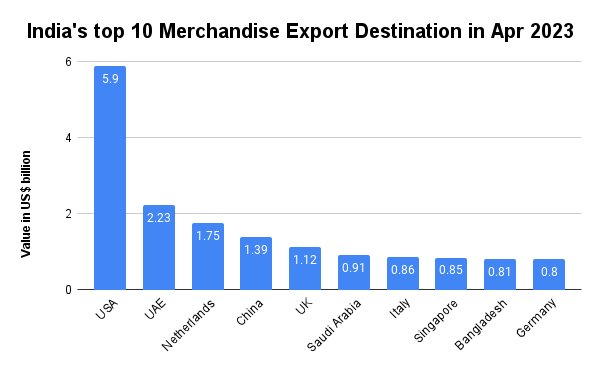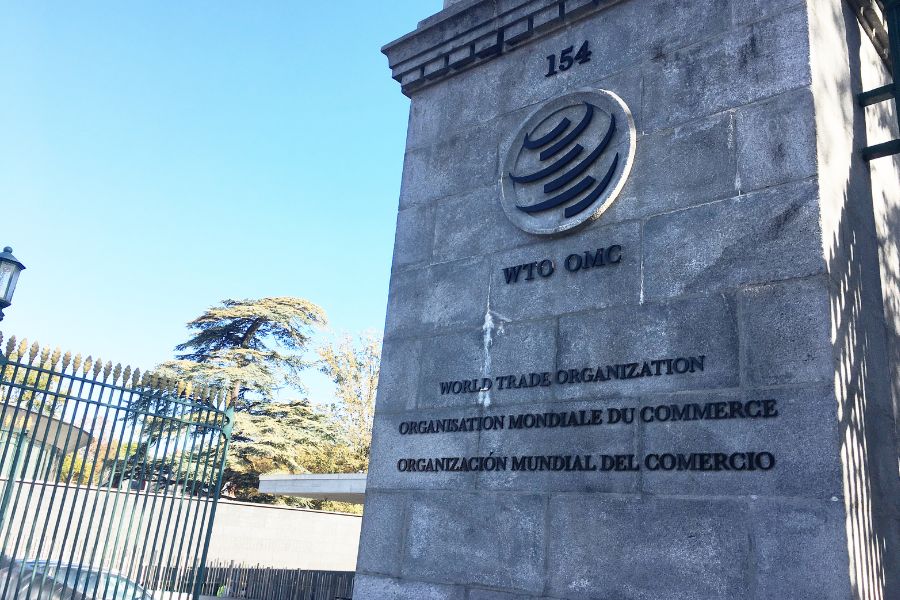Global slowdown’s impact on India’s trade
India’s trade deficit reached a 20-month low in April, shrinking to US$ 15.2 billion. The decline in goods exports and imports can be attributed to lower commodity prices and weakened demand in Europe and the US.
- Exports of goods in April declined by 12.6%, marking the steepest fall since August 2020.
- Merchandise imports contracted 14.1% to $49.9 billion, the sharpest decline since October 2022.
- Services exports showcased resilience, with an estimated 26% increase in April.
- Potential recovery is anticipated from September onwards, driven by the reopening of the Chinese economy and increased demand in Europe and the US.

Image Credit: Shutterstock
The recently released trade data indicates that both India’s exports and imports have witnessed a significant decline in the face of a global economic slowdown. The global economic slowdown, characterized by sluggish growth and reduced demand, has had an impact on India’s trade. While the goods trade has been negatively impacted, it’s worth noting that the services sector has showcased more resilience.
Export, Import and Global Slowdown
Decline in overall trade: In April, India’s exports stood at US$ 34.7 billion, marking a 12.6% decline compared to the previous year. This steep fall is the largest since August 2020. The downward trend has persisted for three consecutive months, indicating a significant slowdown in global demand. The decline can be attributed to reduced commodity prices and a decrease in the demand for gems, jewellery, and readymade garments in Europe and the US.
Imports in April contracted 14.1% to US$ 49.9 billion, representing the sharpest decline since October 2022. This is the first time since August 2021 that monthly shipments into India have fallen below the US$ 50 billion mark. The reduction in imports can be attributed to weak demand and decreased discretionary spending in Europe and the US. The sectoral data, particularly in petroleum, supports the notion that falling commodity prices have influenced both exports and imports.
Services export resilience: While goods trade faced a significant downturn, India’s services exports showcased strength. Services exports in April were estimated to have increased by 26% to US$ 30.4 billion, while imports witnessed a 17% increase, reaching US$ 16.5 billion. This positive trend provides some solace amid the overall decline in trade. The growth in services exports can be attributed to sectors such as IT services, software development, and business process outsourcing, which continued to thrive despite global economic challenges.
Sectoral Overview
Under merchandise exports, 11 of the 30 key sectors exhibited positive growth in April 2023 as compared to the same period last year.
|
Major sectors witnessing positive growth |
||
| Oil Meals (95.14%) | Electronic Goods (26.49%) | Rice (24.01%) |
| Oil Seeds (18.01%) | Ceramic Products & Glassware (17.21%) | Spices (14.44%) |
| Drugs & Pharmaceuticals (10.45%) | Fruits & Vegetables (9.96%) | Tobacco (6.28%) |
| Coffee (4.17%) | Cereal Preparations & Miscellaneous Processed Items (2.03%) | |
Source: Ministry of Commerce & Industry
- Oil Meals experienced an impressive growth of 95.14% in export. Rice export increased by 24.01% YoY, while Oil Seeds witnessed a growth of 18.01%.
- Exports of electronic goods grew by 26.49% YoY to US$ 2.11 billion in April 2022. However, this is lower than March 2023, when exports of electronic goods stood at US$ 2.86 billion.
- Non-petroleum & Non-Gems & Jewellery exports witnessed a negative growth in April 2022 which stood at US$ 25.76 billion as compared to April 2022 which was US$ 28.37 billion.
Market Overview

Source: Ministry of Commerce & Industry
The US was India’s top trade partner in 2022-23, with trade valued at US$ 128.78 billion, followed by China, UAE, and Saudi Arabia.
However, India’s exports to the UAE, with which it signed a CEPA last year, witnessed a decline by 22% YoY to US$ 2.23 billion in April ’23. Additionally, imports from the UAE also declined sharply by 34.08% to US$ 3.15 billion. Similarly, exports to the US contracted by 17.16% to US$ 5.9 billion, while imports declined by 24.67% to US$ 3.14 billion. The other export destinations where India’s exports reported negative growth included China (4.31%), Singapore (28.7%), Bangladesh (43.31%), and Germany (14.44%) during the month under review.
Final Word
Looking forward, the near-term demand scenario appears less optimistic, with expectations of continued sluggishness for the next two to three months. Global trade growth in 2023 is expected to be subpar despite a slight upgrade to GDP projections in WTO’s forecast on 5 April. The war in Ukraine, persistently high inflation, tighter monetary policy and financial market uncertainty are expected to constrain global merchandise trade volume to 1.7% this year.
However, there is hope for a potential recovery from September onwards. Factors such as the reopening of the Chinese economy and a boost in demand from Europe and the US could breathe new life into global exports. These developments could positively impact India’s trade prospects, potentially reversing the downward trend witnessed in April.













Leave a comment